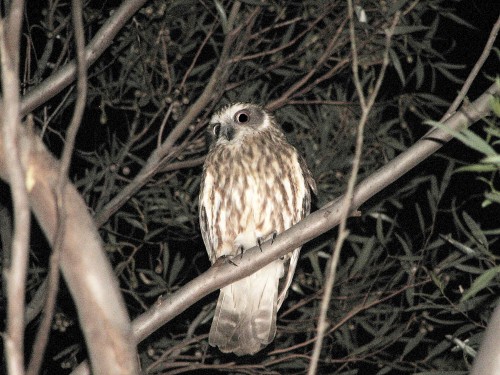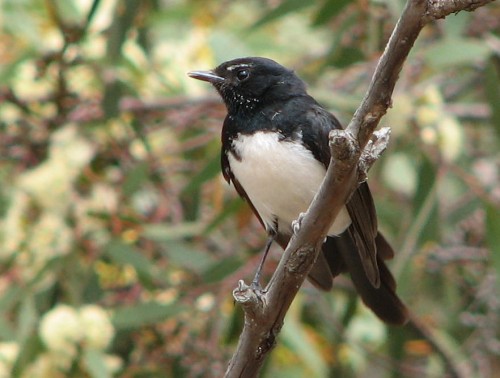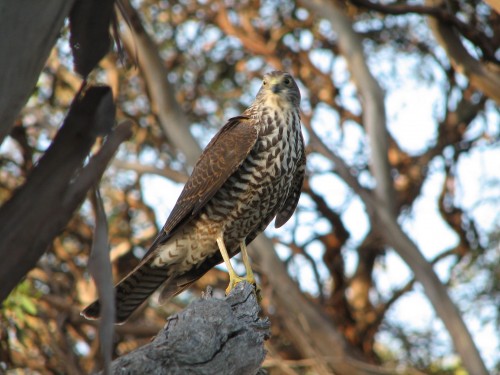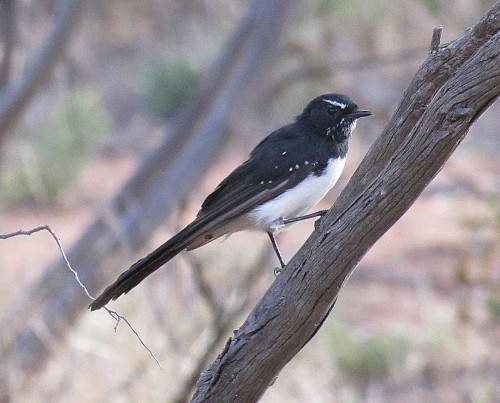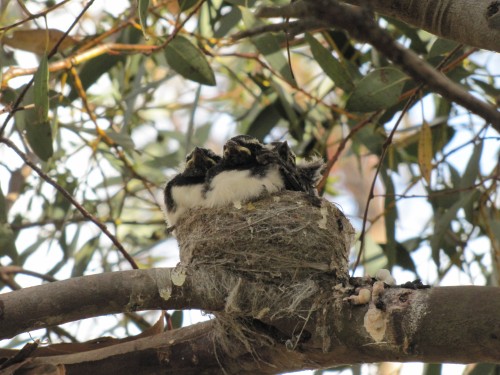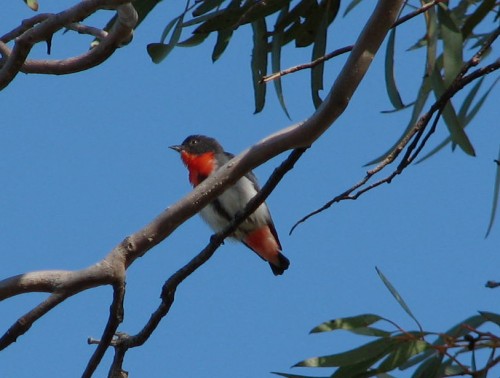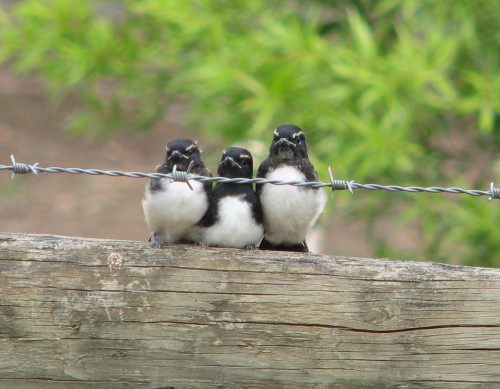A special night visitor
Last night we had a wonderful visitor to our garden. Just before we turned on the television we heard the unmistakeable call of a Southern Boobook Owl in our garden. I immediately grabbed a powerful torch and head outside. Unfortunately the bird not only stopped calling, it must have flown off. I searched a few of the trees where I thought that the sound had been coming from but to no avail. Never mind, it was good to hear it and know that this species is still around.
It was a special visitor because we are so infrequently aware of this species of owl in our garden or in our little patch of mallee scrub about 80km east of Adelaide, South Australia. We actually hear it only a few times a year – at best. I guess we should switch off the television more often. Or perhaps I should head off with a torch and walk the “estate” more often – all five acres of it!
Because the bird we heard last night did not hang around very long, there was no opportunity to grab the camera for a photo. The photo above – possibly the same bird – was taken in one of our trees a year or so ago. On that occasion the bird obligingly posed for two photos.
Update October 13th: we heard it again this evening. This time it was closer to the house and we had a good view of it – twice in a few days is special.
Other nocturnal birds
Below is a list of nocturnal birds I have recorded on our property. Click on each to go to articles and photos of them.
A brave Willie Wagtail
A few days ago I wrote about our feisty Willie Wagtail (click here to read the article). I made some comments about some of the birds I had seen our resident Willie Wagtails chasing off from near their nest. They can get very protective of the nest, the eggs and especially the young once they hatch.
Yesterday I looked out of the window and saw it again attacking a much larger bird. Because of the distance – about 40 metres – I was not sure what it actually was, but it was ducking every few seconds as the Willie Wagtail attacked its head. Fortunately my binoculars were within reach but as I grabbed them the bird flew off to another part of the garden near the front of the house with the noisy Willie Wagtail snapping at its tail.
I went to the sun room and looked out at a bush nearby. The much larger Collared Sparrowhawk was cowering in bush, trying valiantly to escape from this angry little bird. I was able to get a good view of the hawk before it flew off again, hotly pursued by the Willie Wagtail until it was well away from the nest.
Their resilience and sheer bravery in the face of great odds always amazes me. Quite the inspirational little bird.
The photos on this post were taken some time ago. I should keep my camera handy too.
Further reading:
A feisty Willie Wagtail
One of the most recognisable Australian birds would be the Willie Wagtail (see photo above). It is also one our most endearing birds, a favourite of many people. It loves occupying spaces close to human habitation, especially our gardens. We have a resident pair in our garden and we see them on a daily basis.
I have always known that Willie Wagtails can also be aggressive, feisty little birds. This has been in evidence in recent days in our garden, illustrated by the following incidents when it has attacked other, much larger species:
- Australian Magpies: our resident Magpies must be nesting somewhere on our five acre property here in South Australia. The male is consistently chasing almost every bird which comes near. Fortunately us humans are never swooped. Last Saturday, however, the roles were reversed. It was the magpie being chased – by a very aggressive and angry Willie Wagtail snapping at its tail as it tried to escape its wrath.
- Little Ravens: We often have small flocks of Little Ravens in our garden, usually up to about six or so. Yesterday I heard and then saw three ravens in the large mallee trees at the back of our home. As usual, they were cawing loudly. This attracted the attention of the Willie wagtail who rapidly came into the situation and began snapping at a raven’s feathers, tail and head, harassing the poor bird mercilessly. As soon as one raven flew off with a few caws in protest, the Willie Wagtail would turn its attention to another until all three were well and truly seen off the property.
Wedge-tailed Eagles
I have only observed Australia’s largest bird of prey, the Wedge-tailed Eagle, on one occasion here in over 30 years. It is, however, quite a common bird throughout this part of the country and I have seen the species on many occasions in my travels. It always amazes when the tiny Willie Wagtail – not much bigger than a humble House Sparrow – aggressively attacking the eagle, snapping at it and even pecking at its back while hitching a ride. Such courage – one snap of the eagle’s beak would dismiss the wagtail permanently.
The reason for this aggressive attitude:
Normally the Willie Wagtails are friendly, docile birds. They will allow all manner of birds to cohabit happily in our garden. The reason for this sudden change of attitude is a simple little nest, like the one shown below. The photo below was taken a few years ago because I don’t want to disturb the mother Willie wagtail. She is currently sitting on two lovely eggs. She is not even afraid to come after me when I get near to the nest, snapping near my head until I move a reasonable distance from the nest.
The weeds near the nest will just have to wait a few weeks to be mown. Sigh.
I recently wrote about other birds nesting in our garden (click here).
A Mistletoebird pays a quick visit
Yesterday my wife and I were taking a short break from the jobs we had been doing. Sitting on our back veranda we were enjoying the lovely sunny spring weather we have had this week. It was afternoon tea time and we were enjoying a well deserved cup of tea. The back veranda has been a bit of a mess over the winter months and the weather has been too cold to spend too much time cleaning it up. Now that the spring weather is here we had a renewed enthusiasm for being outside.
While we sat there we enjoyed the constant parade of birds hopping around in the garden nearby. Many others were calling and we enjoy trying to identify them by call alone, a good way of honing one’s identification skills. Our resident Superb Fairy-wrens entertain us every day, as do the Mallee Ringneck parrots, the Eastern Rosellas and the Galahs. We can’t work out if the Galahs are actually nesting or not. The Spotted Turtledoves often join in the chorus and in recent days we have had the delight of Peaceful Doves also hanging around near the house.
As we sat there we were delighted to have a female Mistletoebird fly in and alight on a bush in full view just three metres from us. We were able to see the soft, dull grey colours of the feathers on her back, a stark contrast with the blue-black feathers of the male (see photo above). I didn’t have the camera handy, and the bird flew off after less than a minute, so I have shared a photo of the male taken some years ago. I do have one photo of the female, but unfortunately it is not in focus. Sigh.
I cannot categorically say that this is a resident species in our garden and on our 5 acre property, but it is certainly a regular visitor. I hear its call almost every week. Many years ago this was the first species to nest in one of the trees we planted after moving here. There may have been other species before it, but this was the first one we positively recorded doing this. The nest is a delicate pear-shaped container with a small entrance near the top. It is made primarily from spiders’ webs, small leaves, lichen and other soft materials, and hangs from small twigs or leaves. They are just coming into their breeding season, so I need to keep an eye open for a nest. This species is found throughout mainland Australia except in the driest regions. It is not present in Tasmania.
Further reading:
- Beautiful Mistletoebird
- Great Birding Moments #3
- If you click on the name of any of the bird species mentioned in the text above, you can go to other articles about that species.
It’s nesting time again
It’s that time of year again in Australia – spring nesting season.
Birds everywhere are making nests, sitting on eggs in nests or feeding young just out of the nest. In southern Australia – the region I am most familiar with – the “spring” nesting season stretches from the winter months of July and August, through the entire season of spring (September – November) and even well into summer (December – January).
Having confused all of my overseas readers I should explain three things:
- Most of the breeding occurs in the spring months.
- Some species – like our honeyeaters – will nest multiple times, raising 2 or more broods a season.
- Some species will even raise as many as five broods over a six month period.
Being late September nesting is in full swing here on our 5 acre (2 hectare) property in Murray Bridge, South Australia. The following is a quick annotated list of those species I have observed in the breeding mode in recent weeks:
Willie Wagtail: our resident birds have been very quiet and I suspected that they had a nest somewhere but I only found it yesterday. It contained two eggs. The photo above shows a fluffy family of Willie Wagtails just out of the nest a few years ago.
New Holland Honeyeater: last week I saw two parent birds fussing over and feeding two fledglings just out of the nest and barely able to flutter, let alone fly.
Red Wattlebird: I saw one bird sitting on a nest high in one of our trees but haven’t checked it in recent days. Other wattlebirds in our garden are being bossier than usual, so I guess that there are young around somewhere.
House Sparrow (introduced species): they always seem to be mating and nesting, so nothing unusual there.
Common Starling (introduced): the resident dozen or so birds all seem to have taken up occupation of a number of tree hollows in our mallee scrub, but I haven’t yet heard the persistent calls of the nestlings begging to be fed.
Mallee Ringneck parrots: our resident birds were feeding young a month or so ago, and I have seen them constantly investigating a tree hollow. Earlier this week we saw two of them mating, so the next brood could be on the way soon.
Cuckoos: I haven’t seen any cuckoos yet this season but I have heard Horsfield’s Bronze-cuckoos calling several times, so they could possibly be nesting too.
Galah: I’m not sure what our Galahs are doing. They come to a hollow in an old growth mallee tree near our clothes line and enter the hollow every day but nothing else seems to be happening. This has happened now for several years so I will just have to keep an eye on proceedings.
Australian Magpie: this is a really puzzling one. The resident magpies showed all the right activities a few months ago when they defended their territory but since then everything has gone quiet. We daily see several birds feeding around the garden and in the paddock, but I have yet to locate a nest. Very strange.
I have highlighted just 9 species in this article. Over the last 30 years I have observed many more species either breeding, or feeding young, on our property. I am quite confident that there would be other species currently nesting somewhere here, possibly including:
- Grey Shrike-thrush
- Common Blackbird (introduced)
- Spotted Turtledove (introduced)
- Crested Pigeon
- Yellow-rumped Thornbill
- Weebill
- Spotted Pardalote
- Striated Pardalote
- Mistletoebird
- White-plumed Honeyeater
- Spiny-cheeked Honeyeater
- Singing Honeyeater
- Little Raven
- Pacific Black Duck (they bring the ducklings to our swimming pool!
- Superb Fairy-wren
- Australian Magpie-lark
- Grey Butcherbird
Further reading:
Click on the following article headings to read about successful breeding attempts in past years:
- We have baby Willie Wagtails
- New Holland Honeyeater nest
- Red wattlebirds with young
- House Sparrows eating berries
- Very Common Starlings – nesting
- Mallee Ringnecks nesting
- Horsfield’s Bronze-cuckoo
- Possible Galah nesting attempt
- Baby Magpie – this is the most popular article on this site with nearly 500 reader comments.
